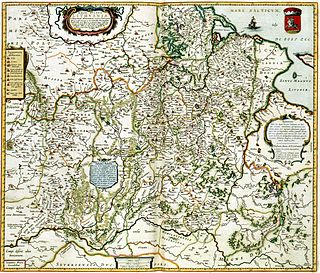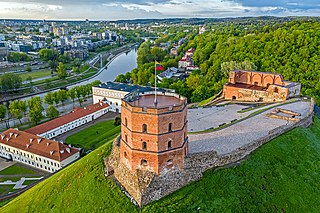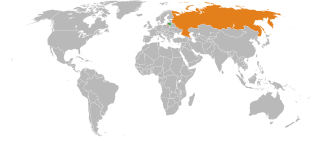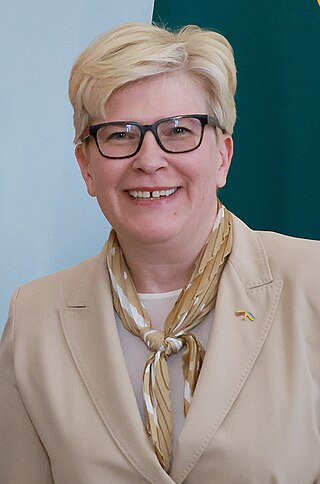
Lithuania, officially the Republic of Lithuania, is a country in the Baltic region of Europe. It is one of three Baltic states and lies on the eastern shore of the Baltic Sea. It borders Latvia to the north, Belarus to the east and south, Poland to the south, and Russia to the southwest, with a maritime border with Sweden to the west. Lithuania covers an area of 65,300 km2 (25,200 sq mi), with a population of 2.86 million. Its capital and largest city is Vilnius; other major cities are Kaunas, Klaipėda, Šiauliai and Panevėžys. Lithuanians belong to the ethnolinguistic group of the Balts and speak Lithuanian, one of only a few living Baltic languages, and the most widely spoken.

The history of Lithuania dates back to settlements founded about 10,000 years ago, but the first written record of the name for the country dates back to 1009 AD. Lithuanians, one of the Baltic peoples, later conquered neighboring lands and established the Grand Duchy of Lithuania in the 13th century. The Grand Duchy was a successful and lasting warrior state. It remained fiercely independent and was one of the last areas of Europe to adopt Christianity. A formidable power, it became the largest state in Europe in the 15th century spread from the Baltic Sea to the Black Sea, through the conquest of large groups of East Slavs who resided in Ruthenia. In 1385, the Grand Duchy formed a dynastic union with Poland through the Union of Krewo. Later, the Union of Lublin (1569) created the Polish–Lithuanian Commonwealth. During the Second Northern War, the Grand Duchy sought protection under the Swedish Empire through the Union of Kėdainiai in 1655. However, it soon returned to being a part of the Polish–Lithuanian state, which persisted until 1795 when the last of the Partitions of Poland erased both independent Lithuania and Poland from the political map. After the dissolution, Lithuanians lived under the rule of the Russian Empire until the 20th century, although there were several major rebellions, especially in 1830–1831 and 1863.

Lithuania is a Northern country on the south-eastern shore of the Baltic Sea, a member of the United Nations Organisation, the Organisation for Security and Cooperation in Europe, the European Union, the North Atlantic Treaty Organisation, the World Trade Organisation. Currently, Lithuania maintains diplomatic relations with 186 states Lithuania became a member of the United Nations on 18 September 1991, and is a signatory to a number of its organizations and other international agreements. It is also a member of the Organization for Security and Cooperation in Europe, NATO and its adjunct North Atlantic Coordinating Council, the Council of Europe, and the European Union. Lithuania gained membership in the World Trade Organization on 31 May 2001.

Vilnius is the capital and largest city located in Lithuania. As of July 2023, Vilnius's estimated population was 593,436. The Vilnius urban area extends beyond the city limits and has an estimated population of 718,507 in 2020. By November 2023, there were approximately 768,342 permanent residents in Vilnius city and Vilnius district municipalities combined.

The Grand Duchy of Lithuania was a European state that existed from the 13th century to the late 18th century, when the territory was partitioned in 1795 among the Russian Empire, the Kingdom of Prussia, and the Habsburg Empire of Austria. The state was founded by Lithuanians, who were at the time a polytheistic nation born from several united Baltic tribes from Aukštaitija.

The Lithuanian Soviet Socialist Republic, also known as Soviet Lithuania or simply Lithuania, was de facto one of the constituent republics of the Soviet Union between 1940–1941 and 1944–1990. After 1946, its territory and borders mirrored those of today's Republic of Lithuania, with the exception of minor adjustments to its border with Belarus.

Lithuania is divided into three layers of administrative divisions. The first-level division consists of 10 counties. These are sub-divided into 60 municipalities, which in turn are further sub-divided into over 500 smaller groups, known as elderships.
Territorial changes of the Baltic states refers to the redrawing of borders of Lithuania, Latvia and Estonia after 1940. The three republics, formerly autonomous regions within the former Russian Empire and before that of former Polish–Lithuanian Commonwealth and as provinces of the Swedish Empire, gained independence in the aftermath of World War I and the Russian Revolution of 1917. After a two-front independence war fought against both Bolshevist Russian and Baltic German nationalist forces, the countries concluded peace and border treaties with Soviet Russia in 1920. However, with World War II and the occupation and annexation of these republics into the Soviet Union twenty years after their independence, certain territorial changes were made in favour of the Russian SFSR. This has been the source of political tensions after they regained their independence with the dissolution of the Soviet Union. Some of the disputes remain unresolved.

Lithuania is now a country in the Baltic region of Europe.

The following outline is provided as an overview of and topical guide to Belarus:

The following outline is provided as an overview of and topical guide to Estonia:

The following outline is provided as an overview of and topical guide to Latvia:

The following outline is provided as an overview of and topical guide to Poland:

The Soviet–Lithuanian Mutual Assistance Treaty was a bilateral treaty signed between the Soviet Union and Lithuania on October 10, 1939. According to provisions outlined in the treaty, Lithuania would acquire about one fifth of the Vilnius Region, including Lithuania's historical capital, Vilnius, and in exchange would allow five Soviet military bases with 20,000 troops to be established across Lithuania. In essence the treaty with Lithuania was very similar to the treaties that the Soviet Union signed with Estonia on September 28, and with Latvia on October 5. According to official Soviet sources, the Soviet military was strengthening the defenses of a weak nation against possible attacks by Nazi Germany. The treaty provided that Lithuania's sovereignty would not be affected. However, in reality the treaty opened the door for the first Soviet occupation of Lithuania and was described by The New York Times as "virtual sacrifice of independence."

Lithuania–Russia relations are the bilateral foreign relations between Lithuania and Russia. Lithuania has an embassy in Moscow and consulates in Kaliningrad and Sovetsk. Russia has an embassy in Vilnius. The two countries share a common border through Kaliningrad Oblast.

Belarus and Lithuania established diplomatic relations on 24 October 1991, shortly after the dissolution of the Soviet Union. The two countries share 680 kilometres (420 mi) of common border. Lithuania's border with Belarus is the country's longest border. For Belarus it is its 3rd-longest border.

The Belarus–Lithuania border is an international border almost 678.8 km (421.8 mi) in length between the Republic of Belarus and the Republic of Lithuania. It is an external border of the European Union as well as the western border of the Commonwealth of Independent States. 379.9 km (236.1 mi) of the border is on land, while 298.9 km (185.7 mi) are on water, crossing lakes, e.g. Lake Drūkšiai and following some rivers, e.g. Dysna River and Neman River.

Ingrida Šimonytė is a Lithuanian politician, public servant and economist who is the 17th and current prime minister of Lithuania since 11 December 2020. She has been a Member of the Seimas for the Antakalnis constituency since 2016 and was Minister of Finance in the second Kubilius cabinet from 2009 until 2012. Šimonytė was a candidate in the 2019 presidential election, but lost in the second round runoff to Gitanas Nausėda. She has been a member of Homeland Union since 2022, having previously been an independent politician.

Litvinism is a branch of nationalism, philosophy and political current in Belarus, which bases the history of its state on the heritage of the Grand Duchy of Lithuania and emphasizes the Baltic component of the Belarusian ethnic group. According to this branch of Belarusian nationalism, the Grand Duchy of Lithuania was a Slavic or Belarusian state, the medieval Lithuanians were Belarusians, and modern Lithuania is a consequence of a falsification of history. On the other hand, some Russian Litvinists refer to the Grand Duchy of Lithuania as a Slavic Russian state.
























